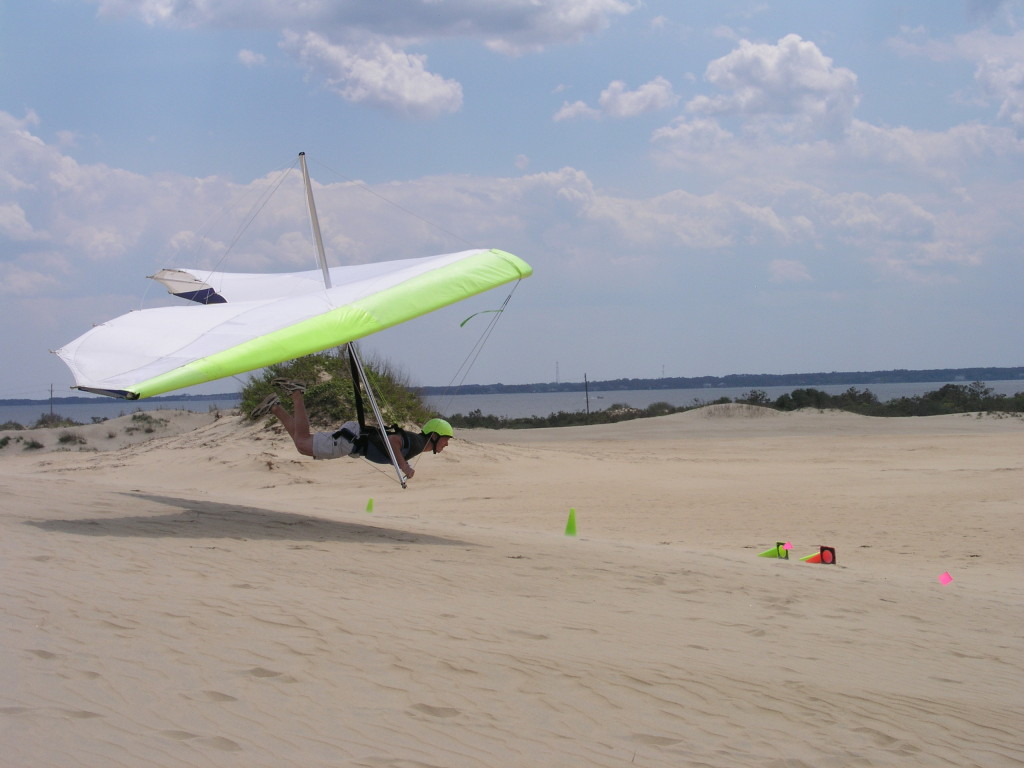FreeFlight Advice: Proper Prone Form
February 18, 2014
Originally published in Hang Gliding and Paragliding Magazine, January 2014
I first heard PPF when I started flying with “Dangerous Dave Gibson”, so I’m going to go ahead and credit him for the term. Known by many other names, albeit less concise, PPF stands for Proper Prone Form.
In our early hang gliding training we learn how to control a glider from the uprights. At some point we begin having higher, longer flights and it becomes practical (for comfort mostly) to lay down and fly “prone” on the base tube. We get taught how to transition down to the base tube, and how to transition back to the uprights. We learn how to get in and out of our harness. But PPF seems to be something most learn over time and with experience, much more so than specific instruction.
PPF and precision control is a requisite for doing the close and fast work Dave performs here for a professional video shoot.
In addition to being observant of people’s flying styles, I have recently become a mentor for some pretty advanced pilots. I’ve been finding that “PPF” is something people can stand to benefit from- especially at the H3 and up level. Proper prone form has many benefits, the biggest being the ability to be more precise in your inputs, as well as conservation of energy (which really helps on long flights, or many consecutive flying days!).
A little history- flying prone was an evolution of the sport to improve performance, because the frontal area of a prone body is far less than in the seated position where hang gliding originated. Proper prone form maximizes the performance gain by minimizing drag and physical exertion.
First step, get loose! Your whole body should be relaxed, and letting the harness support you. Of course that requires a proper fitting harness, which is important beyond just comfort. With your body loose, your shoulders, elbows, wrists and hands need to be loose, too. Obviously you use these muscles to weight shift (as well as your core, as we’ll talk about later), but when not weight shifting you should be as loose as possible. Loose hands are essential- it’s HANG gliding, not HOLD ON gliding. If you’re death gripping the base tube, you are throwing out valuable information about your wing and the air you are in. In fact, contact with the glider should be as light as practical. I strongly prefer to fly with open palms, and just my fingertips on the top of the base tube. Finger tips are very sensitive, and the light contact allows you to really feel out the wing and air. Flying that loose takes practice, but working on it pays huge dividends in the quality and precision of your flying.
From this angle we can see Dave is a master of the light grip, and is pulling IN while making contact only with the front of the base tube.
Once you’re loose and sensitive to your wing, it’s time to focus on “conservation of motion”. What that means is not making unnecessary inputs, or over doing the inputs that are necessary. True conservation of motion is only possible once you are really feeling the wing, so it’s important to go in order. Some turbulence is just turbulence, while other turbulence can turn the wing or require pitch input… and being loose and sensitive helps decipher if any input is needed. When an input IS needed, try to shift your weight slowly and smoothly. Big ‘stabs’ of weight shift are inefficient, and with them comes more adverse yaw… which can sometimes lead to requiring more input to correct bank or course heading. Slower, smooth inputs also let you keep lighter contact on the wing, better feeling how much input to give and how long to hold it.
When you shift your weight to the side, it’s important to keep your body aligned with the airflow. The draggiest harness pointed straight into the airflow is still cleaner than a slick race harness turned sideways! To do this, focus on steering with your hips. Don’t pull your shoulders over, or push your feet over… bring your hips over, and use your core to keep your body straight.
Do not, under any circumstances, push down on the top of the base tube! Because the control frame is raked forward, the base tube is forward of your hang-point… which means any weight transmitted onto the basetube is a nose-down pitch input, whether you know it or want it. In addition to not being loose and sensitive to the wing, pushing down makes it very difficult to accurately judge and manage airspeed. Bar position becomes irrelevant, because the glider is now flying faster than it should be for a given bar position. Done to it’s extreme, pushing down on the base tube leads to straight arms with locked elbows… which severely handicaps your ability to control the glider. Pushing down also rocks your body more upright, which again is terribly inefficient no matter how racy your harness might be. I have observed many H3’s and 4’s that are guilty of this bad habit, so don’t feel too bad if you’re a base-tube-pusher-downer. Please break that habit immediately, and thank Dave Gibson for his eloquent terminology of “PPF”.
Here we can see what flying fast looks like when not using proper prone form. Straight arms limit pitch range, control and feel. Rocking head-up further limits pitch control, as well as being aerodynamically inefficient.
To avoid pushing down on the base tube, remember to stay loose, and then take the term “pull IN” literally. Pull the base tube back toward your feet and in toward your body. Think about trying to pull the center of the base tube to your belt buckle. Pushing down on the base tube requires contact with the top of the base tube, so when you want to fly fast treat the top of the base tube like hot lava. Pulling IN only requires contact with the front “leading edge” of the base tube, and in smooth air can be done with completely open hands.
Here we can see the author flying fast using a loose grip, making contact with only the front of the base tube, and pulling the base tube back toward his belt buckle.
If you can learn to relax and loosen your body, to fly with a light touch, to smooth and conserve your body motion, and keep your body aligned with the airflow- I promise you will see huge performance gains… both in your flying, and your physical performance. You will climb better, being more in-tune with your wing and where the best lift is. You will glide better eliminating unnecessary drag from your body or wing (unnecessary glider inputs deform the wing creating drag). You will be more accurate of a pilot, too- being able to feel the need for and apply very minute corrections. And you’ll be less fatigued, able to fly longer more comfortably… and won’t be sore (or at least as sore) after many consecutive days.
PPF and precision control is a requisite for doing the close and fast work Dave performs here for a professional video shoot.
Looking at the best pilots in the sport, it’s easy to see a common body type… and none of them look like body builders. Larry Tudor was pretty much a bean-pole! The truth is hang gliding is a finesse sport, and PPF is a crucial way for advancing pilots to take their flying to “the next level”. Weight shift is just another way of saying “balance”, and in every balance sport- running, skating, skiing, gymnastics… the top athletes are those that have learned to maintain disciplined control of their bodies and use economy of motion.
Enjoy!






